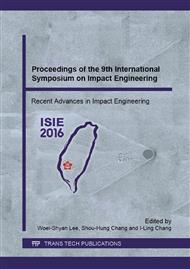p.95
p.101
p.107
p.111
p.116
p.122
p.128
p.133
p.139
Experimental Characterization of Crack Growth Behavior in Adhesive Interface under Impact Loading
Abstract:
A novel experimental method has been developed to evaluate the mode I crack growth behavior of adhesively bonded joints under impact loading. The split Hopkinson pressure bar (SHPB) technique and the digital image correlation (DIC) technique was employed to evaluate the crack growth behavior. To reduce the dynamic effects by controlling loading input of the SHPB apparatus, the fracture toughness was determined precisely based on static evaluation formula. To contrive the testing set-up, high loading rate was kept until the arrest of crack. The fracture toughness of titanium alloy/epoxy adhesively bonded joints during crack propagation was obtained successfully by using present method.
Info:
Periodical:
Pages:
116-121
Citation:
Online since:
September 2016
Authors:
Price:
Сopyright:
© 2016 Trans Tech Publications Ltd. All Rights Reserved
Share:
Citation:


